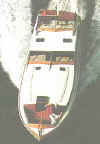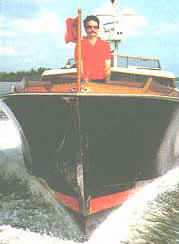Midnight Lace
Midnight Lace 44 |
||||||||||||||||
|
|
|||||||||||||||
| "Midnight Lace was inspired by the slippery
old hulls that were developed during the age of the rumrunner," Fexas says.
"In the heyday of Consolidated, Elco, Dawn and others, yards turned out boats that
were both elegant and fast - and that was before the days of high-horsepower, lightweight
engines." The current trend in production boat building has been toward beamy boats. It has been that way for over ten years, and there seems to be no indication of change. The reason why major builders are producing beamy boats is simply that the market demands it. Customers want large interior accommodations. But beamy boats require more power to push through the water. That translates into bigger, more costly engines for planing hulls, and higher fuel consumption at planning speeds. That Midnight Lace looks a bit like a torpedo boat is no accident. The experiences with the light strong hit-and-run PT boats of World War II taught designers much about getting speed out of available horsepower. So, for starters, Lace is light. Fexas built the hull with Airex core material as the matrix and added extra layers of glass reinforcement in all the stress locations. He knew that the beamy production boat, with all its extra structural material and the heavy machinery needed to push it around, could fall easily into a "closed loop" system of power requirements - the more weight, the more power needed, thereby adding more machinery weight... and so on... Midnight Lace does not plane in the classic sense. Planning requires that a boat lift and pull her chines and transom clear of her wake. For a boat with more conventional Length/Bean ration (in the neighborhood of 3) and broad, flat sections to plane (without the assist of dragproducing trim tabs) requires plenty of power. Consequently, skippers often run at the cutting edge of planning speed, failing to break the boat clean and free the chines. But Lace gets up and sets herself at her modest 2 degree running angle at about 11 knots - a figure considerably lower than most other boats of her length. The reason for this is what Fexas calls his "penetrating" hull form. The hull design design concept involves narrow sections, a fine entry, and long, flat buttocks and fairbody. Most important, the chines are rounded. In fact, all the corners below the waterline, including the bottom edge of the transom, are faired round to reduce drag that would otherwise occur at speeds where her chines and transom are still immersed. Lace doesn't plane, she slices. Along with the advantages of the slim, penetrating hull form, the increase in the Length/Beam ration creates a stability picture that differs considerably from more conventional boats. Lace is less stable than her production counterparts. This is not to say that she will capsize easily - quite the contrary, hr ultimate stability is high, due to her low profile and light superstructure. The lower initial stability simply creates a long, slower roll period than that of other boats. Where her beamy sisters can sometimes tend to roll with a snap, Lace is more gentle. Engineering Models of Lace were tanktested at Stevens Institute and at the Webb Institute model basin. The parent hull model that was the result was a combination of the features that proved successful during the tests, including the long run and buoyant after sections that were found to keep squatting and the resultant drag at the transom to a minimum. To keep the interior free of clutter, Fexas decided to put the engine well aft, under the cockpit - another reason for the high-buoyancy stern sections. The engines - Renault RC 210 DTS diesels, with 2:1 reduction through V-drive units, turning (ideally) 22x23 props - were expected to be more than adequate. Representatives from Renault tested the boat's performance and were completely satisfied at the results, calling the test,"...a tribute to the design of the bottom of this yacht." Renault's figures boiled down to the following: Fuel consumption: 18.8 gph at 27 knots, 10.5 gph at 20 knots, and 4 gph at 10 knots. Fuel: 200 gal, range at cruise: 380 nm. Cruising Displacement: 17,500 lb. Style Because of her long, clean running attitude, Lace is styled to reduce windage, and that styling adds to the overall effect. All forward-facing surfaces on the superstructure are raked aft. Windshield (there's one on the forward cockpit, to slant back to spill wind up and over the crew. All molding and trim is In keeping with this aerodynamic flow. Fexas treats the principles of aerodynamics as if he just discovered them. The boat is like Art Deco afloat. At the cutwater, spray chines begin and sweep aft, gradually fairing and disappearing into the smoothness of the bilges on either side. These are important in keeping the level-running boat dry while she slices along. But not all the Lace's styling is practical. There's an almost fanatical use of brightwork. It's one of the things that grabs you right away. In a world of white and off-white fiberglass, Lace stands out like a trophy. With her black hull and bright deckhouse, she's glass but looks like a wooden goldplater. Seemingly the best of both worlds. Below, Lace is just that - lace. The appointments are truly luxurious, the kind of luxury that calls forth images of J.P. Morgan, Old Greenwich, Newport in the days of Vanderbilt, crushed velvet. The conveniences are there (fridge, huge double stateroom, high and airy dinette) but they're really secondary to the ambient elegance. A place for drinking rum, not running it. |
||||||||||||||||




